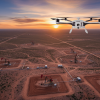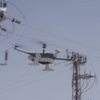Market validation for drone-in-a-box technology is stronger than ever
“Are drone-in-a-box really a valuable, reliable tool for critical infrastructure and heavy industry?” Around 2015-2016, I used to get that question frequently from stakeholders looking for a much-needed solution to enhance safety and reliability for their organization. While the question was phrased politely, what I was really hearing was, “This technology is so new—does it really work?”
Fast forward to 2023, and I’m almost never asked that question. That’s because the market has provided a clear answer—a resounding yes! Market validation for drone-in-a-box (DIB) technology (also known as drone docks) can be seen everywhere: industry leaders are seeing real value and ROI from the technology, regulators are providing their stamp of approval, new use cases continue to emerge, and new players continue to join the market, most notably Skydio and DJI.
If you take a closer look at what the market is saying, first and foremost it recognizes the immense value DIB technology has to offer. The mainstream, consumer players joining the fast-growing market are a significant signal that there is value here, and the technology is here to stay.
Another huge market signal attesting to the value of the technology is the increasing scale of DIB deployment. Leading energy and heavy industry stakeholders are increasingly deploying tens, if not hundreds of drone-in-a-box solutions across their facilities and infrastructure. Here again, the market is saying this technology is valuable, and it’s also saying that it’s reliable—the questions I was asked in 2015 are no longer on the table.
Together with regulators providing advanced approvals to operate drone-in-a-box Beyond Visual Line of Sight (BVLOS), like this nationwide approval for Percepto drones to operate BVLOS in the US, the market is putting its final stamp of approval on the drone-in-a-box. It’s safe enough to operate without a pilot, and safe to say organizations have a lot to gain by integrating drone docking stations in their workflows.
How to choose a drone docking station for heavy industry
The question is no longer whether critical infrastructure needs autonomous drone monitoring, but rather which of the market solutions best meets their needs. Heavy industry and critical infrastructure facilities are complex, hazardous environments, and companies that manage sites with hazardous materials or provide power to thousands of residents have no room for error. They need solutions that are ruggedized and stable enough for 24/7/365 operations in harsh conditions.
Commercial drones for infrastructure monitoring must be available to function in that environment to ensure reliability, as well as capture and analyze data effectively to generate real-time actionable insights for every facility.
So, how do you choose the right autonomous drone and dock for your needs? Below are the seven key points to consider when investing in a drone docking station solution.
1. Is it field-proven?
Testing facilities never fully reflect real field conditions, and no amount of testing can replace extensive real-world experience in the air and on the ground. Two examples come to mind from Percepto’s work in the field that paint a clear picture of how real-world experience is critical when designing reliable solutions for heavy industry.
The first example is from the discovery stage of a drone-in-a-box deployment in 2015 for a client with harsh on-site winter weather conditions. At the time, our solution featured dual, top-facing doors which opened to both sides. During discovery, we learned that snow and debris would fall into the docking station whenever it opened.
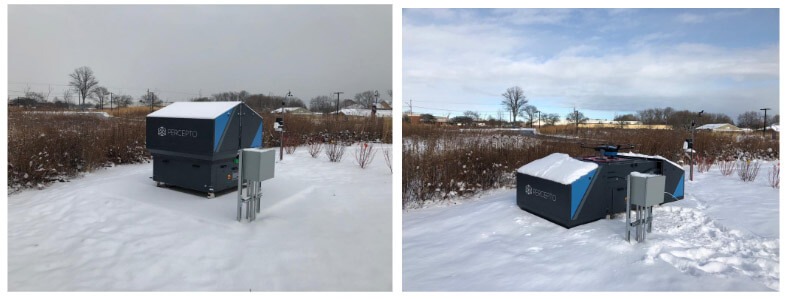
Percepto 2-door original, retired docking station in the discovery phase
This insight from the field led to the modification of Percepto’s drone docking station design to feature a single door that opens to one side. In addition to preventing snow, debris, sand, and dust from falling into the dock, having one door increases the overall solution reliability, eliminating redundant moving parts.
Another example of field insight was in the discovery stage of deployments in hot climates. Heat can make batteries and electric components less efficient. More critically, overheating poses a significant safety risk—if the battery or electric component overheats, it can lead to serious safety concerns or even the risk of explosions. That critical insight led to the addition of a full HVAC (heating, ventilation, and air conditioning) unit that hooks up to Percepto’s drone dock and provides industrial-grade heating and cooling for enhanced safety, the only drone dock with this type of HVAC solution.

Percepto Air Base, single-door design with HVAC unit at customer chemical facility
These are just two examples of many field-driven insights. Newcomers to the autonomous drone industry are just getting started in their discovery stages and need significant time to generate insights and make modifications. Percepto has racked up the most hours in the air at client sites—more than 5,000 hours in a wide variety of industries—giving Percepto a key advantage.
2. Is it ruggedized for outdoor use and set up for 24/7/365 availability?
Heavy industrial sites are often located in remote areas and exposed to extreme temperatures and harsh weather conditions including hurricanes, dust storms, and blizzards. The entire drone-in-a-box solution needs to be ruggedized and reliable enough to withstand conditions like high winds, remain available on site, and collect data, even in an emergency.

Percepto Air Max prepares for hurricane season in Florida
The ruggedized Percepto Air Base is the all-weather heavyweight champ. Sturdy and ruggedized, it is the only drone docking station currently available that is proven to check all the boxes for 24/7/365 operations in harsh conditions, including hurricane-level winds, rain and snow, dust, sand, salt, and extreme temperatures.
3. Is it regulation ready?
The key advantage of DIB technology is that it is fully unmanned. In order to leverage that advantage, you need regulatory approval to operate the drone “Beyond Visual Line of Sight” or BVLOS. These approvals are generally granted on a case-by-case basis, in a time-consuming, lengthy process. However, in an industry breakthrough, Percepto drones and drone docking stations were the first to receive nationwide BVLOS approval with no need to apply for individual approvals.
4. How does the drone communicate?
In order to operate autonomously, drones need reliable communication with their docking station at all times. However, in facilities under construction or remote PV farms and mines, Wi-Fi simply isn’t available and alternative communication solutions are a must. LTE, whether 4G or 5G, is the best option for unlimited outdoor drone communication,
Percepto Air drones, on the other hand, come with ready-to-launch LTE communications. They don’t require any new infrastructure on site, leveraging the key benefits of DIB as an autonomous, ready-to-go, easy solution.
5. Can it operate day and night?
Problems don’t sleep at night, and neither can drones. To maintain flight reliability and perform tasks that take place after dark, such as shutdown progress, an autonomous drone needs to be able to operate day and night, even in low visibility conditions. Percepto Air drones have that covered—they’re equipped with daylight and thermal cameras and are fully operational in both day and night.
6. Choose a company that can provide the payload you need
For critical infrastructure and heavy industry, you need a drone docking solution backed by industry experts with a deep understanding of industry-specific challenges, and the know-how to implement value-adding solutions for any use case.
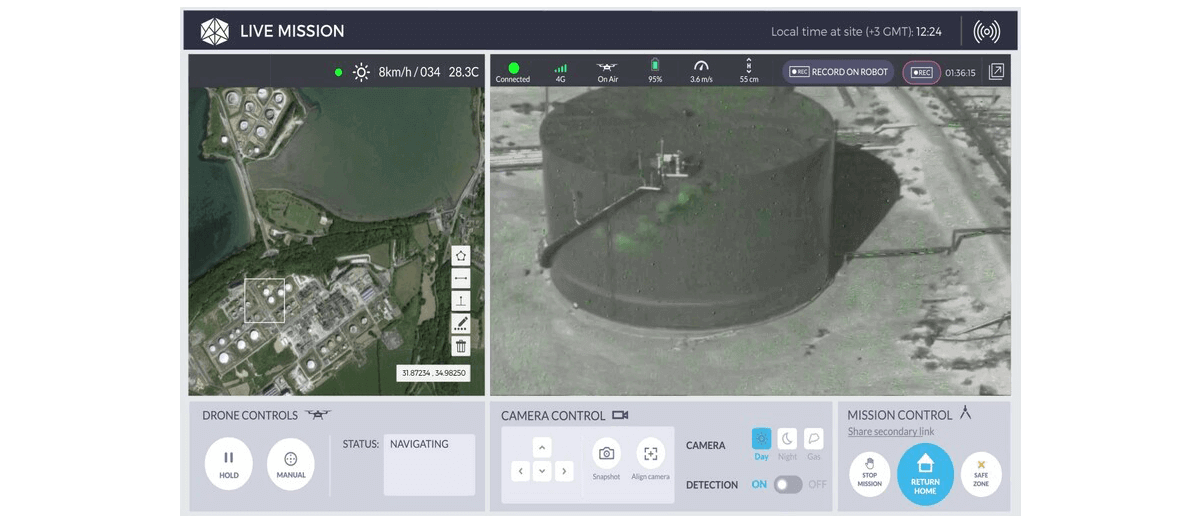
Autonomous gas detection with OGI payload
For example, for oil & gas stakeholders, a major challenge faced on a daily basis is improving facility safety and reducing their carbon footprint. For these stakeholders, delivering an autonomous gas detection solution allows them to detect fugitive emissions safely and frequently, without sending employees into the field to perform hazardous inspections. Optical Gas Imaging (OGI) payloads on drones deliver just that solution, and are becoming a must-have tool for the industry.
Delivering a reliable, autonomous drone solution with OGI payload requires a high level of industry expertise. For example, OGI cameras detect the motion of gasses, and when placed on a moving drone, that can be a complex task. Currently, the Air Max OGI is the only drone-in-a-box solution on the market equipped with an OGI camera, and has already been deployed at several refineries to detect emissions frequently and safely.
Another great example of a critical payload to meet an industry-specific challenge comes from the energy and utilities industry. To detect thermal anomalies in critical infrastructure such as transmission and distribution lines, radiometric cameras, rather than thermal cameras, are a must. Radiometric cameras can evaluate multiple parameters at the pixel level including distance from the object, humidity, emissivity, and more. Here again, equipping drone-in-a-box with the right payload is critical to solving real-world challenges. Delivering a solution with radiometric cameras paired with powerful thermal image analysis software to energy and utilities allows them to detect thermal anomalies such as loose connections, faulty components, or insulation issues to prevent outages and deliver reliable power to communities.
7. Does the solution deliver automated insights and reports?
Getting the hardware right for 24/7 outdoor inspections—all the above-mentioned features and parameters from communications to ruggedness and payload—is the “easy” part. When done correctly, it enables frequent, reliable, and high-quality data collection.
But that’s not enough. To deliver actual value to stakeholders, you also need to manage and analyze the large quantity of data collected. From our experience working with Fortune 500 organizations worldwide, we learned that some, if not most of the stakeholders don’t even care how the data is collected. They just want a report in their inbox so they can maintain their infrastructure’s reliability and safety.
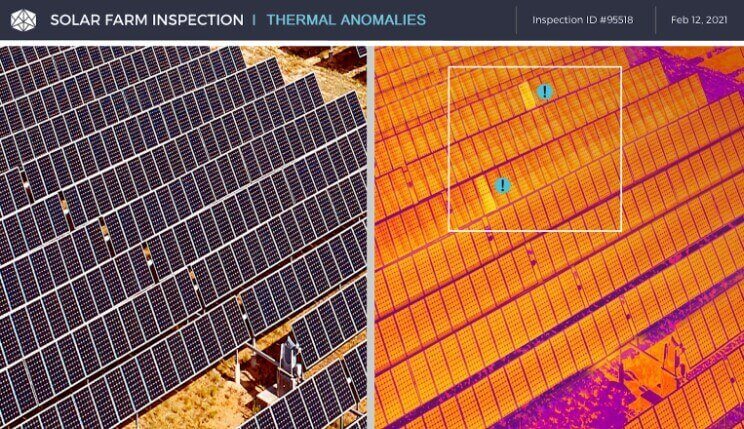
Thermal anomaly report at PV farm
To enable automated reporting, you need advanced algorithms to deliver industry-specific insights, such as thermal anomaly detection to direct maintenance crews to faulty electric components in power grids, solar panels, or substations. You need a high level of expertise in the subject matter and use case at hand.
More critically, to develop working, industry-specific data analysis tools you need massive quantities of relevant field data.
In other words, you need to have a solution running at customer sites for years to feed and perfect your algorithms with real-world images and video.
Only one drone docking solution checks all the boxes
For critical infrastructure, drone docking stations are a must-have tool for 2023. The drone market has sent its strongest signals ever that the technology is mature, safe, and has immense value to offer. Having an on-site drone-in-a-box available for visual inspections 24/7/365 is critical to maintaining infrastructure reliability, safety, and sustainability. The question is no longer, “Do I really need this technology?,” but, “Which drone-in-a-box can provide the data and insights my organization needs?” And only one solution checks all the boxes.



